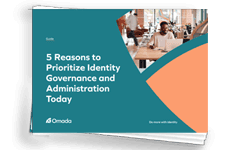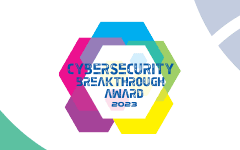Let's Get
Started
Let us show you how Omada can enable your business.
• Full-featured IGA
• Configurability without code
• Best-practice framework for solution design and deployment
• High degree of configurability
• Intelligent compliance
• Manage identities and access across hybrid platforms
• Support at every step of your IGA journey
• Personalized service package to accelerate your deployment
• Avoid common pitfalls and get value in 12 weeks
• Iterative implementation roadmap
• Standardized, well-documented best practices
• Support from Omada-certified project managers, architects, and consultants
• Stellar Customer Success Team
• Quick and professional Service Desk
• Access to ITSM system and KPI reports
• Digital self-paced and instructor-led courses
• Training on demand through our Premier Academy subscription
• Individual, role-based learning plans and certification paths
• Ensure fast and successful IGA deployment
• 5-step process with clear exit criteria
• 12 weeks time to value
• Helps support enterprise IT security
• Makes it easier to meet compliance mandates
• Automates access provisioning and enables the workforce from day 1
• Automated access provisioning and deprovisioning
• Least privilege and separation of duties policies
• Simple-to-run certification campaigns
• Access compliance status dashboards
• Cross-system certification campaigns
• 50+ audit report templates
• Identity lifecycle management
• Automatic access provisioning
• Self-service access requests
Omada provides Governance for Identity Fabric ensuring compliance regulations are met, security and efficiency around identity workflows are maintained.

A definite guide to Identity Governance and
Administration best practices. Learn how to
successfully deploy and maintain an IGA solution.

Our comprehensive Identity and Cybersecurity
glossary, featuring extensive explanations, real-life
examples, practical frameworks and everything else
you need to understand key concepts in identity and
cybersecurity.

In this Guide, Gartner has identified Omada as a
Representative Vendor in IGA. Use it to evaluate top
Identity Governance vendors and anticipate future
trends, features, and capabilities in the IGA market.

Familiarize yourself with the typical threats that
can derail a seamless legacy to cloud migration of
IGA functionality and get tips on managing them.

As part of their digital transformation, DEKRA moved
from an in-house access management solution to
a modern, cloud based Omada IGA solution.

Get practical examples and data proving the
value of IGA and learn the five key reasons you
must make it a business imperative today.

Explore our white papers on compliance, security, and
efficiency topics. Gain insights and best practices to drive
informed decisions and enhance your organizational strategy.

We are constantly adding new features to Omada
products to ensure your IGA efforts keep pace with
the ever-evolving threat landscape.

Get information about the newest Omada product
features, benefits, and use cases to ensure you get
the most from your IGA program.

Participate in interactive product demos covering
capabilities such as Delegate Access, Request
Access, Approve Access Request, and more.

Get the latest IGA trends, information, and intelligence
from renowned industry experts in Omada’s live and
on-demand webinar presentations.

A market-leading provider of identity governance
and administration solutions. Get to know us better!

At Omada, efficient teamwork creates extraordinary results.
We enable talented people to create career paths where
they can thrive, be inspired, and have fun.

Omada partners provide unmatched advisory, product
and service re-sale, and project delivery resulting in
unsurpassed customer satisfaction scores.

Don’t just take our word about the value of Omada
solutions. See what actual users think.

See what the media are reporting about our
innovative identity governance solutions.

We frequently deliver expert presentations, exhibit, and
run demos at the world’s leading security and IGA events.
Look at our upcoming schedule to see if we cross paths –
we'd love to speak with you.

Omada is a winner for a third consecutive year in the 7th
annual CyberSecurity Breakthrough Awards program.

Omada is a global market leader in Identity Governance.
Please reach out to us with questions or to get more information.

Find here legal documents governing and relating to the
provisioning of Omada Offerings - Customer Agreement, DPA, and more.
• Full-featured IGA
• Configurability without code
• Best-practice framework for solution design and deployment
• High degree of configurability
• Intelligent compliance
• Manage identities and access across hybrid platforms
• Support at every step of your IGA journey
• Personalized service package to accelerate your deployment
• Avoid common pitfalls and get value in 12 weeks
• Iterative implementation roadmap
• Standardized, well-documented best practices
• Support from Omada-certified project managers, architects, and consultants
• Stellar Customer Success Team
• Quick and professional Service Desk
• Access to ITSM system and KPI reports
• Digital self-paced and instructor-led courses
• Training on demand through our Premier Academy subscription
• Individual, role-based learning plans and certification paths
• Ensure fast and successful IGA deployment
• 5-step process with clear exit criteria
• 12 weeks time to value
• Helps support enterprise IT security
• Makes it easier to meet compliance mandates
• Automates access provisioning and enables the workforce from day 1
• Automated access provisioning and deprovisioning
• Least privilege and separation of duties policies
• Simple-to-run certification campaigns
• Access compliance status dashboards
• Cross-system certification campaigns
• 50+ audit report templates
• Identity lifecycle management
• Automatic access provisioning
• Self-service access requests
Omada provides Governance for Identity Fabric ensuring compliance regulations are met, security and efficiency around identity workflows are maintained.

A definite guide to Identity Governance and
Administration best practices. Learn how to
successfully deploy and maintain an IGA solution.

Our comprehensive Identity and Cybersecurity
glossary, featuring extensive explanations, real-life
examples, practical frameworks and everything else
you need to understand key concepts in identity and
cybersecurity.

In this Guide, Gartner has identified Omada as a
Representative Vendor in IGA. Use it to evaluate top
Identity Governance vendors and anticipate future
trends, features, and capabilities in the IGA market.

Familiarize yourself with the typical threats that
can derail a seamless legacy to cloud migration of
IGA functionality and get tips on managing them.

As part of their digital transformation, DEKRA moved
from an in-house access management solution to
a modern, cloud based Omada IGA solution.

Get practical examples and data proving the
value of IGA and learn the five key reasons you
must make it a business imperative today.

Explore our white papers on compliance, security, and
efficiency topics. Gain insights and best practices to drive
informed decisions and enhance your organizational strategy.

We are constantly adding new features to Omada
products to ensure your IGA efforts keep pace with
the ever-evolving threat landscape.

Get information about the newest Omada product
features, benefits, and use cases to ensure you get
the most from your IGA program.

Participate in interactive product demos covering
capabilities such as Delegate Access, Request
Access, Approve Access Request, and more.

Get the latest IGA trends, information, and intelligence
from renowned industry experts in Omada’s live and
on-demand webinar presentations.

A market-leading provider of identity governance
and administration solutions. Get to know us better!

At Omada, efficient teamwork creates extraordinary results.
We enable talented people to create career paths where
they can thrive, be inspired, and have fun.

Omada partners provide unmatched advisory, product
and service re-sale, and project delivery resulting in
unsurpassed customer satisfaction scores.

Don’t just take our word about the value of Omada
solutions. See what actual users think.

See what the media are reporting about our
innovative identity governance solutions.

We frequently deliver expert presentations, exhibit, and
run demos at the world’s leading security and IGA events.
Look at our upcoming schedule to see if we cross paths –
we'd love to speak with you.

Omada is a winner for a third consecutive year in the 7th
annual CyberSecurity Breakthrough Awards program.

Omada is a global market leader in Identity Governance.
Please reach out to us with questions or to get more information.

Find here legal documents governing and relating to the
provisioning of Omada Offerings - Customer Agreement, DPA, and more.
Home / What is Technical Identity?


A Technical Identity refers to the collection of identifiers, credentials, attributes, and access permissions that define how a person, system, or entity interacts with and is recognized within a digital or technical environment. It is a descriptor of how someone or something is identified, authenticated, and authorized in technical environments.
Unique values that identify the entity (e.g., usernames, email addresses, device IDs, IP addresses).
Items used to authenticate the identity, such as passwords, security tokens, or biometric data.
Metadata or additional information linked to the identity, such as job roles, device types, or organizational affiliations.
Specifies what the identity is allowed to access or do within a system (e.g., read, write, execute permissions).
Techniques used to verify the identity, such as multi-factor authentication (MFA), single sign-on (SSO), or public-key infrastructure (PKI).
A developer logging into a system with a username, password, and a security token.
A smartphone identified by its MAC address or IMEI number when connecting to a network.
A microservice interacting with other components using API keys or certificates.
Organizations use the identifiers, credentials, attributes, and access permissions that define individual users or systems to inform whether they are authorized to access specific resources and for how long they should have permission to access them.
Technical Identity enables organizations to track who or what performed specific actions for audit and compliance.
Technical Identity enables organizations to manage access rights across diverse on-premises and cloud-based systems with multiple users and devices.
When systems within an IT architecture recognize Technical Identity, organizations integrate and communicate across the entire digital ecosystem.
Individuals and organizations experience data breaches and other cybersecurity incidents when a Technical Identity is exploited by a malicious actor. Here are some ways to keep technical identities out of the wrong hands:
Use Multi-Factor Authentication, require complex passwords, and enforce regular updates. Encourage using password managers to avoid weak or reused credentials.
Grant users and systems only the permissions they need to perform their tasks and assign permissions based on roles within the organization to simplify identity management.
Enable identity logging to track login attempts, access logs, and identity usage patterns. Perform regular audits to review access permissions, credentials, and identity-related systems.
Store credentials, tokens, and API keys securely using encryption and change them periodically to reduce the risk of compromise.
Conduct regular awareness sessions on phishing and identity-targeted attacks and use email security tools to block phishing attempts. Ensure password recovery processes are robust and not vulnerable to social engineering.
Dynamically adjust security based on risk factors, such as geolocation or device reputation and properly secure and monitor privileged access.
Keep identity management systems, authentication libraries, and operating systems up to date to close known vulnerabilities.
Ensure third-party services managing identities are secure and compliant with security standards.
Use incident response plans to address identity breaches and immediately disable accounts or keys suspected of compromise.
Frameworks like NIST SP 800-63 or ISO 27001 ensure identity assurance and robust identity and access management practices and are important in verifying and validating that an individual or entity is who they claim to be. Run regular penetration testing to identify vulnerabilities that could lead to Technical Identity exploitation.
Use tools to automate the provisioning, updating, and deactivation of identities. Monitor real-time threat feeds to proactively block known identity threats.
Omada Identity Cloud is a next-generation IDaaS platform designed to help organizations manage and protect technical identities, ensure compliance with regulations, and mitigating identity-related cybersecurity risks. Get a demo.



